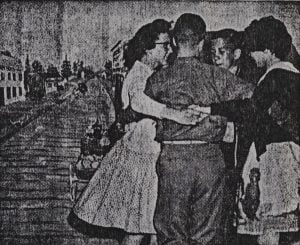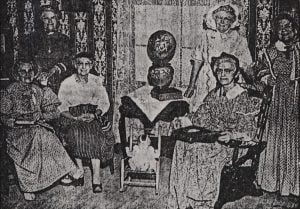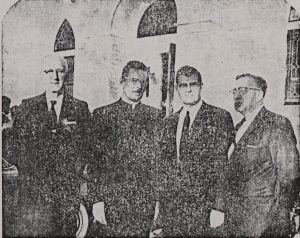The Richland Township Centennial celebration, a vibrant and joyous occasion, marked a significant milestone, commemorating a hundred years of community history with an unmatched spirit of camaraderie and pride. The three-day event was filled with memorable activities, from a talent show kickoff to a grand parade attracting thousands, showcasing the unity and collective effort of the community. Amidst the festivities, the event also offered a moment to reflect on the township’s journey from its pioneering days to its present development, highlighting the enduring spirit of its residents. The centennial not only celebrated the past but also set a hopeful tone for the future, leaving a lasting impression on all who participated.
A Century In Review
by Lorenz H. Loesel

The excitement, the clicking wheel of chance, the screaming siren of the overloaded paddy wagon, and the booming loudspeakers on the amusement grounds of the Richland Township Centennial are mere memories now. Richland celebrated its one-hundredth birthday in the most jubilant and festive manner that the area has ever seen. Never did this community experience such a spirit of sharing, conviviality, and working together to achieve the one main objective—success!
I had the privilege of witnessing nearly every event of the three-day celebration. The Talent Show officially launched the festivities and set the stage for the following events. Manley Kennedy, master of ceremonies, exuded humor and showmanship at the show in the Hemlock High School gymnasium. His subtle humor added spice and flavor to the show, which included local talent, professional talent, young actors, and an array of other acts which made an exciting evening for an audience of over 900.
Immediately following the talent show, Miss Marilyn Nothelfer was crowned queen of the Richland Township Centennial and officially began her reign. Selected to be members of her court were Misses Laura Tessin and Sharon Sanford.
Who could ever forget the parade on June 2 that drew nearly fifteen thousand spectators to witness the panorama of floats, marching bands, drill teams, color guards, horsemen who represented various saddle clubs, old model cars, fire trucks which were relics of bygone eras, historical vehicles, fringe-topped surreys, and many more to form a chain of spectacular sights that spanned themselves over two miles. Even sophisticated adults were drawn to their childhood days, and tears of joy, pride, and mixed emotions were not uncommon.
Even though prizes were awarded for the outstanding entries, I believe that many of the floats and other entries had a much deeper significance. Several of the entries were the fruition of long-range planning. Churches, schools, lodges, business places, and other organizations were more concerned with the theme and motif of their float than with the possible monetary reward. It was the communal spirit of planning, doing, creating, and sharing of time and effort that made the parade one of the most outstanding events.
The old Town Hall, a vintage of the 1880s, was thronged with visitors who wanted a glimpse of early pioneer life. Under the energetic direction and leadership of Miss Mary Rauchholz and Miss Anna Hase, the old building was converted into a museum which displayed the life of the early settler in a most meaningful manner. Among the displays were old photographs, books, letters, pictures yellowed with age, and documents, all of which helped to weave a tapestry of tradition and history depicting the humble beginnings of this community. To add realism to this visual drama, three rooms were completely furnished in authentic antique furniture simulating a living room, kitchen, and bedroom. Many school children toured through the museum, and judging from the rapt expression on their faces as these youngsters filed past the various displays, I was convinced that the committee had succeeded in interpreting the past to an eager-eyed group of boys and girls. Mrs. Jack Hohman operated an old loom for the curious visitors. Many of the youngsters were fascinated by the intricate mechanism of this household tool. Several ladies of this community enacted the scene of an old-fashioned quilting party. The ohs and ahs and rapt attention of the school children attested to the success of these two exhibits.

Let us return to the Centennial Amusement Park and view the cheerful crowd of people who gathered to join the festivities. Bearded men, 19th-century costumes, ladies with starched bonnets and sweeping skirts, little children crying, youngsters begging for an extra nickel or dime, pa with the aid of his cane, meandering slowly but surely to the guarded VFW tent presents a picture engulfing every kind of centennial visitor. It was this human drama of events that added zest and humor to a joyous occasion. We must mention the food for so many hungry visitors. The Jaycees, a group of young businessmen, served barbecued chicken to hundreds and hundreds of people. One of the men told me that the orders came so fast that they were not able to barbecue the chicken the required length of time; but who cared! People were in a festive mood, and a little raw chicken did not dampen the spirit of these eager eaters.
The Old Timers Banquet at the Hemlock Elementary School on Saturday afternoon, June 2, provided another occasion for friends to meet and enjoy a delightful meal of baked ham, baked beans, potato salad, buttered rolls, coffee, and cake. While guests were enjoying their food, the Centennial Orchestra, composed of Harvey Wiltse, Mrs. Grace Oliver, Orvill Otter, and Lloyd Martin, provided entertainment. It was a delightful experience to see the young high school boys serve as waiters, displaying courtesy and friendliness to everyone.
Activities on Sunday, June 3, were centered around the beard judging contest and awarding of a 1962 car. Winners of the beard contest were Bernard Darby, Robert Smith, Albert Beyersdorf Sr., Kenneth Grubaugh, Alvin Scoles, and Lloyd Martin. What a gay time these men had growing and comparing beards for months before the big event!
In the evening, thousands of people gathered to hear the name of the winner of the new car announced. Dr. G. W. Stuart of Saginaw was the lucky man!
A week prior to the Centennial Festival, a pageant was presented at the St. Peter Lutheran School auditorium. It depicted the story, in scene and song, of the early history of the community. Presented on two consecutive evenings and viewed by over a thousand people, “Richland: Its Sons and Daughters” consisted of the following scenes: First Settlers, Cone School, Hemlock School, District Four School, Organization of Richland Township, Logging and Lumbering, Farming with Cradle and Flail, Spinning Wheel, Church Bells in the Forest, the Grim Reaper, Hemlock City in 1873, Township Hall, Hemlock at the Turn of the Century, War Years, and Salute to our War Heroes, Modern Hemlock, and the Finale.
An eight-voice choir, four-piece orchestra, narrator, sixty characters, and ten stage crewmen combined their efforts and talents to present the pageant. Four beautiful scenes were painted for background by Mrs. Carol Tessin Wylie, a former Hemlock resident, and presently an art instructor in Saginaw.
As we think of the past one hundred years of Richland Township and its development, we begin to realize that our community is a typical American picture. When the first settler entered this area, he encountered dense forests, swamps, disease, roadless and neighborless wilderness, and many other discouraging factors that only brave and courageous men and women would challenge. Our early pioneers were endowed with the true American pioneering spirit that brought them to this area and gave them the incentive to clear the forests, build the roads, homes, schools, churches, and establish our present-day society.
A hundred years have passed, and we, the Sons and Daughters of Richland, can point with pride to our community and our heritage. Yes, Richland has flourished. The Hemlock that used to be a full day’s travel from Saginaw is now only a few minutes drive in a modern car. The one-room schools have been replaced by the large modern school which serves merged districts in one unified system. Pioneering churches have grown and developed into larger institutions.
Each and every part of our community is ribboned and surfaced with modern roads and highways, and electrical facilities.

The history of Richland transcends local or township borders. Many of the Sons and Daughters have carried the name of Richland and Hemlock to various parts of the globe. Missionaries, medical men, ministers, merchants, teachers, lawyers, and other professional people are now serving in other areas of the country. May these Sons and Daughters and the ones who stayed at home pledge to make the coming century years of progress and development so that we can point with pride to our native birthplace.
As we leave the memory of the festival for a while, let us spend a few moments at the Richland Township Cemetery and honor the memory of the departed pioneers. Here we find many names inscribed on the memorial stones. Many of these names we have met in the early history of Richland. They are the Cones, Coles, Fitings, Thomases, Dr. O. B. Hale, and many more. In a few instances, we have some difficulty trying to make out the names and dates; however, it reminds us of the erosion and fleeting of time and its ultimate victory over the inevitable destiny of man.
The drudgery of farming and long hours of sweat and toil have been erased by modern machinery.
A former native of Hemlock, Mrs. Alice Pettit Johnson penned the following poem as she visited Hemlock and viewed the green-blanketed cemetery with its beautiful pine and fir trees shading the final resting place of our departed forefathers.
In the Garden of the Dead
I stepped into the garden at sunset, A mourning dove moaned from the pine, It startled my heart to a quickness, So patterned the artful design. Then proving the skill of the Craftsman, A spiced, sodden blanket of breath Awaited to shroud the departing, Such beauty I witnessed in death.
